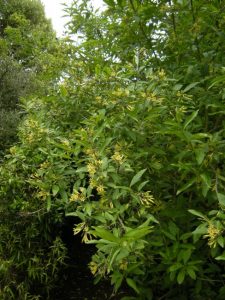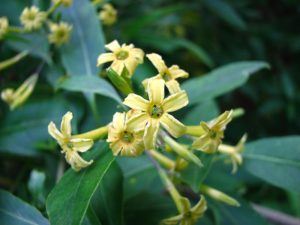Cestrum parqui, a woody member of the family Solanaceae, is making healthy growth in the Garden. It is native to South America, from Brazil to Argentina. This specimen was collected as seed in Chile at an altitude of 1,000m on steep valley sides of the Rio Maule, where vegetation was dominated by Nothofagus species.
Sited in the Garden in the shelter of a dominant Maytenus boaria to the east and a brick wall to the north, this usually semi-hardy deciduous shrub is flowering profusely. There is evidence of winter dieback in dead shoot tips that have not flushed this year, but generally this is a healthy 4m high and broad specimen producing luxuriant growth. The wood, as it ages, resembles Forsythia with the multitudinous covering of raised lenticels.
The greenish-yellow flowers are produced in inflorescences on the current season’s growth. At night they emit a smell not dissimilar to that of gloss paint drying. When trying to place the scent, do not disturb the foliage which has a pungent odour, distinctly unpleasant. The cigar-shaped buds open at the top only to display five flattened petals, leaving the long corolla intact as a tube protecting the flower parts.


